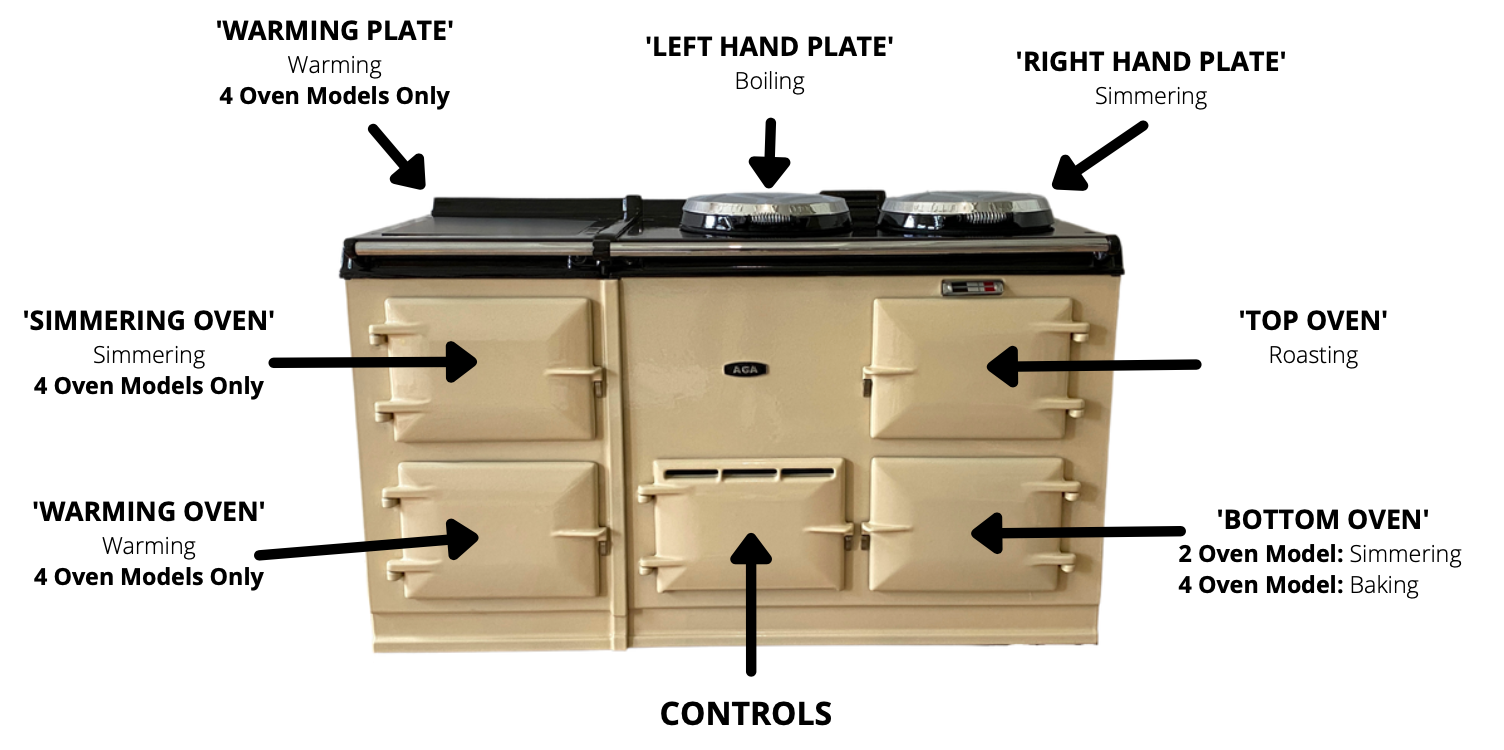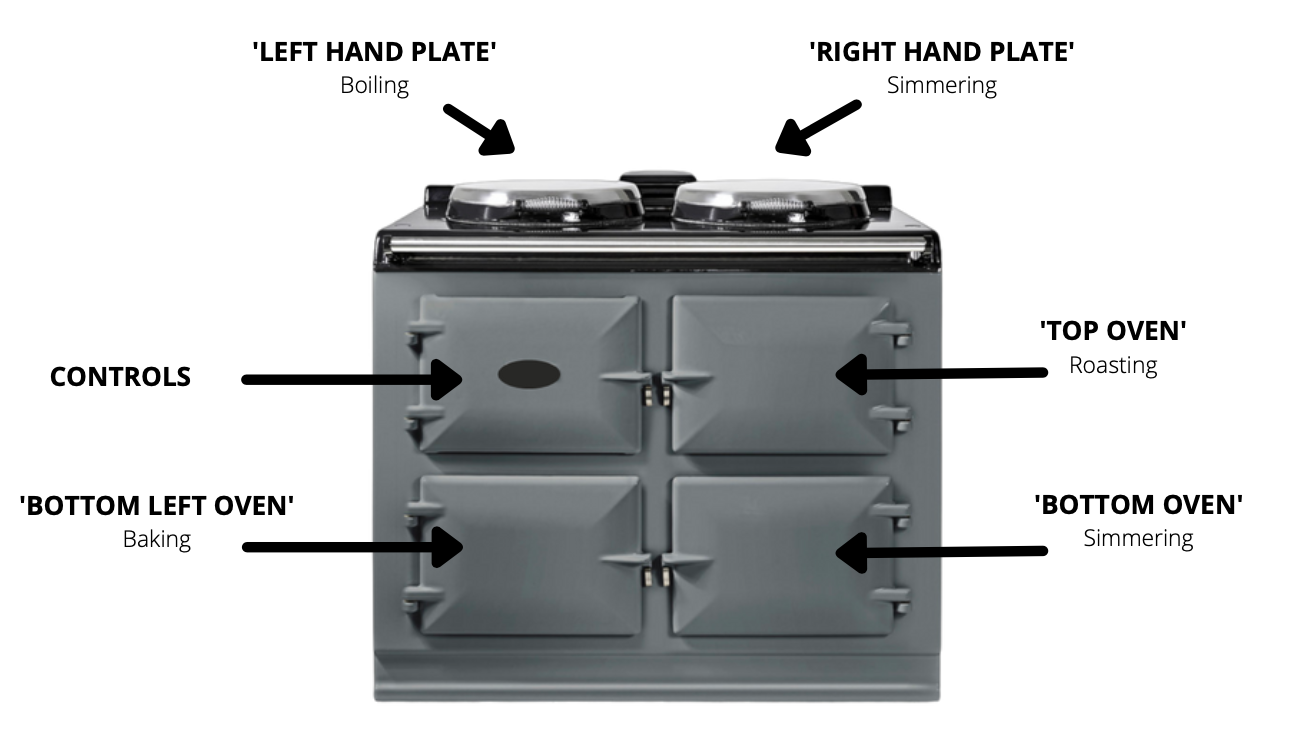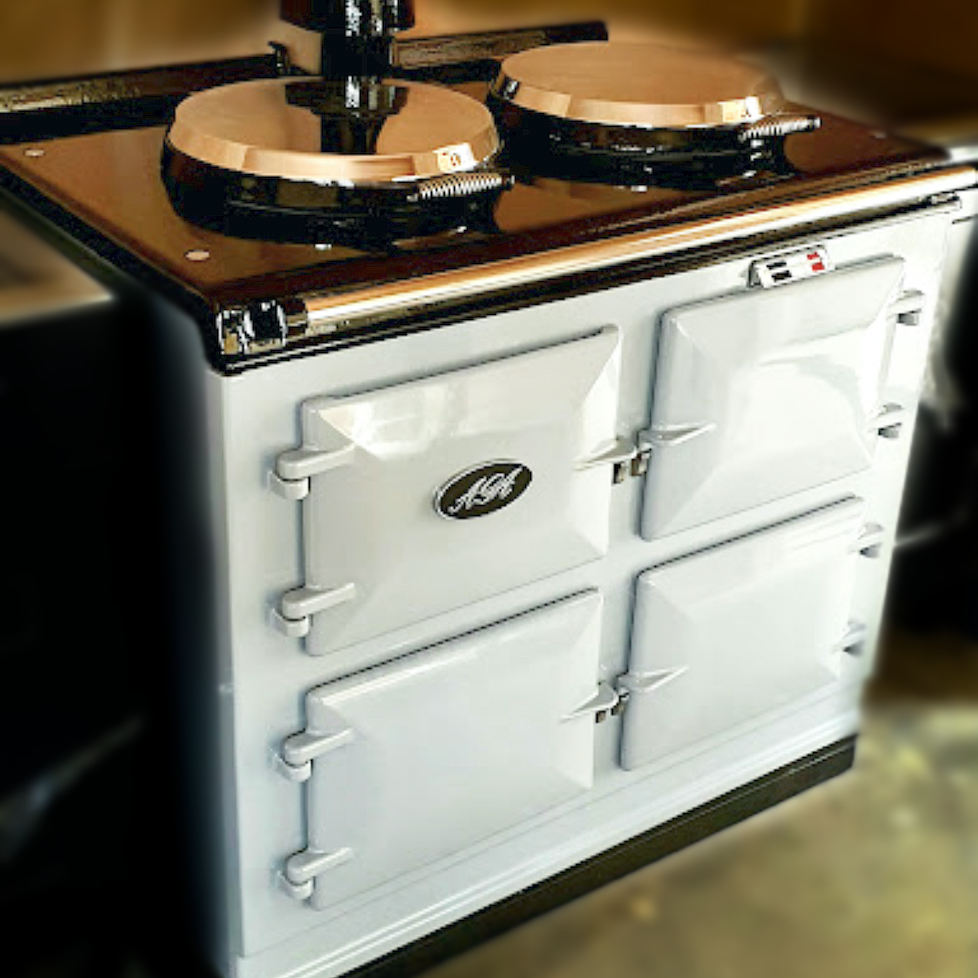Beginners Guide to an Aga Cooker
The Aga cooker is an incredible piece of engineering and can seem daunting for those new to its charm. Have no fear - here's a beginners guide to help.
The below info is an extract from one of our own, comprehensive user guides that we supply alongside our fully refurbished aga cookers.

WHICH OVENS ARE WHICH?!
One of the basics you need to know first - which oven is which!
Unlike conventional cookers, each aga cooker oven has a set temperature. The traditional models of aga cooker are designed to be on, up to temperature, and ready to use 24/7. Controllable on/off models are much more flexible, giving you individual temperature control in each oven and hotplate.
On traditional models, you can vary the temperature inside each oven by moving your dishes to different parts of the oven, or using a cold plain shelf to delfect heat (it'll make sense soon, we promise!).
TRADITIONAL MODEL BASICS
Our Oil, Gas and 13amp models are always on and ready to use. They use conduction and convection to move heat around the huge cast iron parts. The heat is stored inside these castings (including the ovens and hotplates) and any food inside the ovens is cooked using the radiant heat. This is why people say that food cooked inside an aga range cooker, just tastes better. That's because, instead of fans or hot elements blasting the food and drying out the flavour, the moisture is contained within the food.

Here, you can see an aga cooker with all of the loose-fill vermiculite insulation hoovered out, and the front/top removed. The heat will move from your ashpit (bottom left), up through the outer barrel (above the ashpit), then across to the top oven and down to the bottom oven.
Your Aga cooker is thermostatically controlled so once it's tuned to the right setting, theres no need to adjust each time you cook - it's always ready! During the install, we insulate every crevice of the cooker to make sure the majority of the heat stays inside the cooker. The heat that is emitted from the front and top of the cooker will give your kitchen a lovely welcoming warmth all year round.
As your model is always on, it's very efficient at replacing other household appliances you have. You can invest in a stove-top kettle to replace your electric one. Your toaster is redundant since you can make the famous toast your cooker is known for. You can even use the ambient heat to dry your clothes and save running a tumble dryer.
There are lots of tips and tricks for using your Aga range cooker - that's why it's a 'way of life', not just a cooker.
An important note to understand, is that during big spells of cooking (Christmas etc) or times where the lids will be open for a while, the heat inside the ovens will drop. This is due to the way the Aga conducts and distributes heats from a single heat source. Timing and organisation will help for big meals!
FINDING YOUR CORRECT OPERATING TEMPERATURE
Getting exact temperatures of your aga cooker ovens is tricky because of the radiant heat that they use, rather than conventional fan ovens. The temperatures will differ depending on where you place your food in the oven. This is why you can grill at the top of the roasting oven, roast in the middle and fry at the bottom.
The thermometer (heat indicator) on the front plate of your aga cooker, shows the operating temperature of the whole cooker - it's not an oven thermometer. The best way you can make sure your cooker is running at the optimal temperature, is to take readings from the heat indicator first thing in the morning, before cooking, over the course of three days. If you need to adjust, use slight movements and wait overnight before taking another reading.
When you cook on your aga cooker, the thermometer readings will fluctuate over the course of the day as the heat is absorbed into the food and into the room.
You can use a manual oven thermometer that hangs directly in the middle of the grill shelf to get a rough oven temperature.
Your ovens use ambient heat to cook food, rather than direct heat - that's why specific temperatures aren't possible. We'll give you a guide on approximate temperatures for each oven below.
Once your thermometer has reached a position inside the Normal Zone (Silver), your Aga range cooker has reached it's optimal temperature and your ovens should be in their respective temperature zones. Once your controls are set, they shouldn't be adjusted. Your model is designed to be on 24/7 and always up to temperature, ready to use. If you turn it off and let it go cold, it will take around 7 hours to reach full temperature again.
Traditional Aga Cooker Temperatures:
Each aga cooker is different and temperatures will fluctuate but you can use the below approximations as a guide.
Remember, with traditional aga cookers, the oven temperature will drop if you use the hotplates at the same time. Our controllable models won't have this problem.
Roasting Oven: 220-240c
Baking Oven: 170-190c
Simmering Oven: 120-140c
Warming Oven: 60-70c
Boiling Hotplate: 300-340c
Simmering Hotplate: 200-240c
THE 80/20 RULE OF COOKING
The golden rule of cooking is to cook 80% in the ovens and 20% using the hotplates.
Cooking in this way is much more efficient. Every time you lift your hotplate cover, the heat rapidly dissipates and starts removing heat from your ovens too. This is fine for quick dishes, but long periods, like boiling a pot of pasta, would lose lots of heat. That's why many opt to start the boil on the Boiling Hotplate then transfer it into the Roasting or Simmering Oven to continue cooking with the door closed.
If you want to grill dishes, use Runner 1 in the Roasting Oven. In essence, the heat from your burner moves from behind the control door, upwards, along the hotplates from left to right, then down through your ovens. This makes the top of your Roasting Oven the hottest part.
If you want to fry, use the floor of your Roasting Oven. You can even chuck bread on the floor for *very* quick toast!. Pizzas also cook here brilliantly.
We do recommend attending a cookery demonstration with a demonstrator in your area. The cookbooks are great for first-time owners too - we recommend the below books to get started:
The Complete AGA Cookbook by Lucy Young & Mary Berry
The Complete Book of AGA Know-How
by Richard Maggs (this is brilliant for lots of tips and tricks!)
You can watch the wonderful Sarah Whitaker explaining the basics in the video below:
Some Further Reading:







